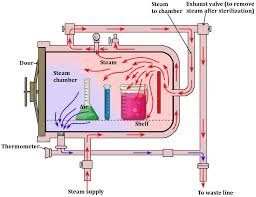Principle and Working of Autoclave

Principle and Working of Autoclave
1. Principle
The autoclave works on the principle of moist heat sterilization using saturated steam under pressure.
-
When pressure is applied to water, its boiling point increases.
-
At 121 °C (15 psi / 1.05 kg/cm² above atmospheric pressure), saturated steam can kill all forms of microorganisms including resistant bacterial spores within a defined exposure time (usually 15–20 minutes).
-
Mechanism of action:
-
Steam penetrates the material.
-
The condensation of steam on a cooler surface releases latent heat.
-
This latent heat rapidly coagulates and denatures microbial proteins and enzymes, leading to cell death.
-
-
Compared to dry heat, moist heat is more effective because steam transfers heat much faster and requires lower temperatures and less time.
2. Working of Autoclave
The working cycle of a steam sterilizer (autoclave) typically includes:
a. Loading
-
Materials to be sterilized are loaded.
-
Items should not be tightly packed to allow free circulation of steam.
-
Indicators (biological, chemical, or physical) are placed inside to validate sterilization.
b. Air Removal
-
Air inside the chamber must be completely displaced for effective sterilization.
-
Methods:
-
Gravity displacement: Steam enters from the top, pushing air out through a drain.
-
Pre-vacuum: A vacuum pump removes air before steam entry (faster and more reliable).
-
c. Sterilization (Holding) Phase
-
Steam fills the chamber.
-
Temperature rises to 121–134 °C at 15–30 psi pressure.
-
Exposure time (commonly 15–30 minutes depending on load type) is maintained.
-
At this stage, microorganisms are killed by moist heat protein denaturation.
d. Exhaust / Depressurization
-
After holding time, steam is released.
-
Pressure gradually returns to atmospheric level.
e. Drying
-
Residual moisture is removed either by continued heating or vacuum drying.
-
Especially important for surgical instruments and sterile equipment.
f. Unloading
-
Once temperature and pressure normalize, the sterilized load is removed.
-
Care must be taken to avoid recontamination.
3. Applications in Pharmaceuticals
-
Sterilization of culture media, glassware, rubber stoppers, gowns, and instruments.
-
Sterilization of certain aqueous preparations.
-
Decontamination of biohazardous waste.
-
Moist heat stability testing during validation.
4. Types of Autoclaves
-
Gravity displacement autoclave (commonly used in labs).
-
Pre-vacuum / high-speed autoclave (used in pharmaceutical production).
-
Bench-top autoclaves (small-scale, research use).
-
Horizontal / vertical autoclaves depending on design.
🎓 Discover one of the best Pharmaceutical Microbiology course available —click below to explore the course that’s shaping future Microbiology course skills.

